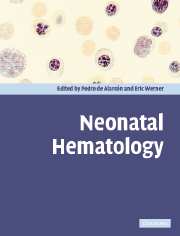Book contents
- Frontmatter
- Contents
- List of contributors
- Foreword
- Preface
- 1 Neonatal hematology: a historical overview
- 2 Disorders of the fetomaternal unit
- 3 Erythropoiesis, red cells, and the approach to anemia
- 4 Anemia of prematurity and indications for erythropoietin therapy
- 5 Hypoplastic anemia
- 6 Hemolytic disease of the fetus and newborn
- 7 Neonatal hemolysis
- 8 Neonatal screening for hemoglobinopathies
- 9 Polycythemia and hyperviscosity in the newborn
- 10 Newborn platelet disorders
- 11 Neutrophil function and disorders of neutrophils in the newborn
- 12 Immunodeficiency diseases of the neonate
- 13 Hemostatic abnormalities
- 14 Transfusion practices
- 15 Umbilical-cord stem-cell transplantation
- 16 Neonatal oncology
- 17 Normal values and laboratory methods
- Index
Foreword
Published online by Cambridge University Press: 10 August 2009
- Frontmatter
- Contents
- List of contributors
- Foreword
- Preface
- 1 Neonatal hematology: a historical overview
- 2 Disorders of the fetomaternal unit
- 3 Erythropoiesis, red cells, and the approach to anemia
- 4 Anemia of prematurity and indications for erythropoietin therapy
- 5 Hypoplastic anemia
- 6 Hemolytic disease of the fetus and newborn
- 7 Neonatal hemolysis
- 8 Neonatal screening for hemoglobinopathies
- 9 Polycythemia and hyperviscosity in the newborn
- 10 Newborn platelet disorders
- 11 Neutrophil function and disorders of neutrophils in the newborn
- 12 Immunodeficiency diseases of the neonate
- 13 Hemostatic abnormalities
- 14 Transfusion practices
- 15 Umbilical-cord stem-cell transplantation
- 16 Neonatal oncology
- 17 Normal values and laboratory methods
- Index
Summary
It is an honor to be invited to write a foreword to this book. I know my friend and late colleague Dr Frank A. Oski, with whom I coauthored three editions of the monograph Hematology of the Newborn from 1966 to 1982, would echo this sentiment. And he would be delighted that his former fellows Drs Werner and de Alarcón shared our interest in the importance of this subject sufficiently to bring it up to date in an expanded textbook rich with information of great scientific and practical value.
As expected, there have been many important advances in the field of neonatal hematology in the past 20 years – new diseases, new ways of diagnosing, treating, and preventing old diseases. These are covered thoroughly in the chapters written by the authors of this book, each chosen carefully by the editors for his or her expert knowledge and experience.
With progress, diseases that virtually established neonatal hematology as a distinct discipline have largely come under control, reducing the space needs for describing them. There is no greater example of this than in the section devoted here to hemolytic disease of the fetus and newborn (formerly referred to as erythroblastosis fetalis), one that represented the largest chapter in our earlier monograph. All this resulted from the successful implementation in 1968 of Rh immunoglobulin to prevent Rh alloimmunization and hemolytic disease of the newborn.
- Type
- Chapter
- Information
- Neonatal Hematology , pp. xiii - xivPublisher: Cambridge University PressPrint publication year: 2005



